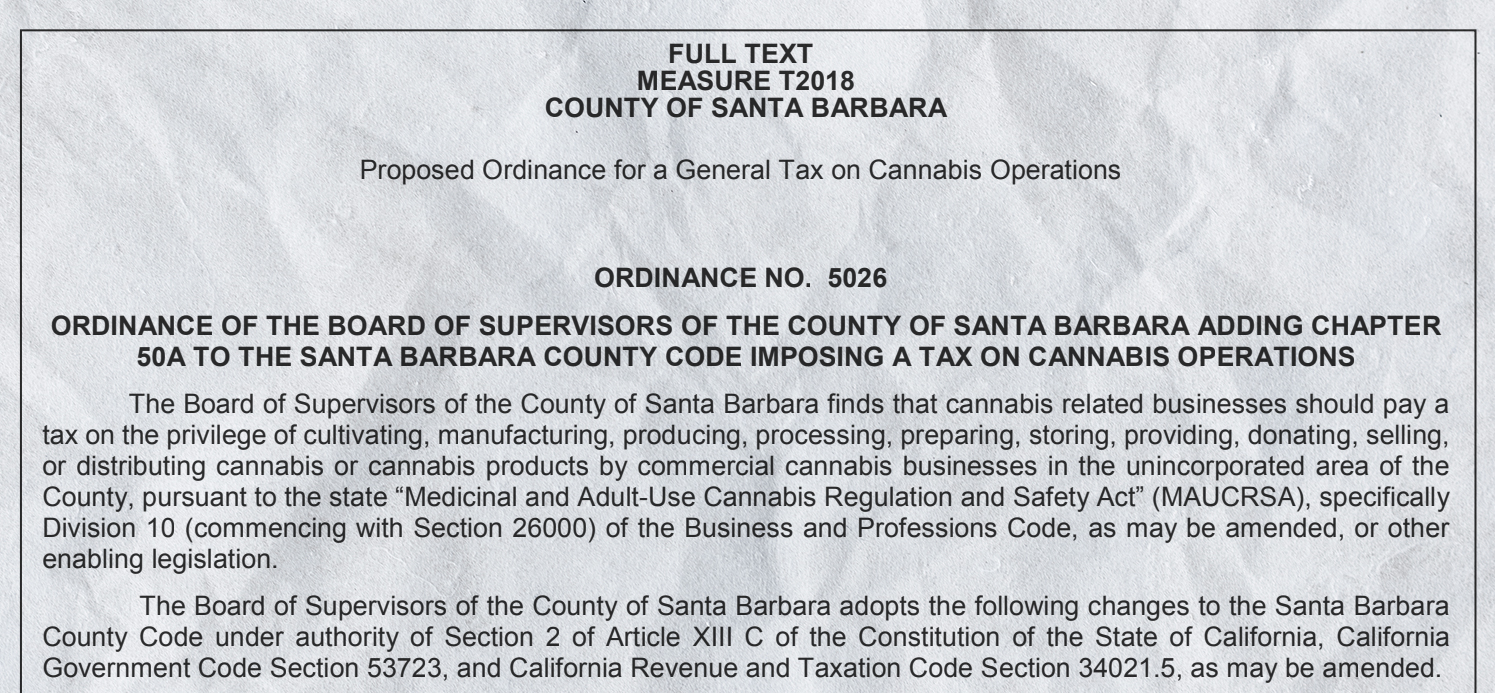Why the County Needs a New Cannabis Policy
Lanny Ebenstein Runs the Numbers on Pot Revenue

This article first appeared at Newsmakers with Jerry Roberts on March 26.
Measure T — the June 2018 ballot measure to regulate and tax cannabis in Santa Barbara County — isn’t working.
Cannabis tax revenues are a small fraction of what they were originally projected to be, as presented in the most recent quarterly update to the Board of Supervisors. When Measure T was placed on the ballot, the campaign on its behalf framed it as a virtual panacea for future county revenue shortfalls.
Supporters and sponsors emphasized the figure of $25 million — the top end of a range of estimates of future annual revenue — as a likely outcome of the measure. County cannabis tax receipts, it was promised, would fund a wide variety of public services.
As stated in the Ballot Argument in support of Measure T, the county’s Cannabis Program would fund “priorities such as the Sheriff’s Department, District Attorney’s office, mental health services, public health and other general services.”
How is the program working, now that it’s been almost five years since Measure T passed? Amazingly, current, 2022-23 net cannabis tax revenue is projected to be less than 2 percent of the $25 million figure presented when Measure T was under consideration.
Current year income and expenses for the Cannabis Program were estimated as follows at the March 14, 2023, meeting of the Board of Supervisors:
the March 14, 2023, meeting of the Board of Supervisors:
- Fiscal Year 2022-23 Cannabis Program Estimated Revenue: $5,779,700
- Fiscal Year 2022-23 Cannabis Program Estimated Expenses: -$3,144,100 Countywide Enforcement Costs – 1,288,400 CEO – Cannabis Program Administration – 345,000 P&D – Appeals Costs – 147,500 P&D – Cannabis Supervising Planner & Planner 3 – 387,100 TTC – Cannabis Program Admin
- $5,312,100 Total expenses
- Bottom line: $5,779,700 minus $5,312,100 = $467,600
The estimated $467,600 net revenue after expenses is 1.87 percent of the much-ballyhooed $25 million forecast.
“Give the government ownership of the Sahara, and in seven years there’d be a shortage of sand,” as my mentor, the late economist Milton Friedman, was fond of saying.
That pesky law of supply and demand. Let’s be blunt: The County Cannabis Program is, in truth, a fiasco.
Not only financially but programmatically, the program has not lived up to its billing. Recall that pro-Measure T ballot argument explained that the Cannabis Program includes an ordinance that establishes “buffer zones around schools, residential neighborhoods and other sensitive areas, and mandates odor controls.”
It is a wholesale understatement to note that not all county residents, taxpayers and non-cannabis businesses agree that these programmatic goals are being met: Currently, there are 13 unique appeals of 11 cannabis projects in the county, 10 of which are on appeal to the County Planning Commission and one of which is on appeal to the Board of Supervisors.
To be sure, not all of the estimated expenses this year of the County Cannabis Program are recurring.
Just under $500,000 of estimated expenses (for appeals and the supervising planner and planner 3 positions) are expected to be one-time.
On the other hand, it is likely there will be new one-time expenses in the future.
In addition, even if the estimated $492,500 of one-time county Cannabis Program expenses were added to the estimated $467,600 of net Cannabis Program revenue this year, this would still total just $960,100 — less than $1 million of net revenue or 3.84% of the over-promised $25 million projected revenue figure (that does not take into account inflation, which should lead to a higher revenue figure at this time than originally expected).
It also is the case that Cannabis Program revenue could be slightly higher in the future than is now estimated for 2022-23. In the first place, the basis for the current year revenue estimate is second quarter tax receipts filed by the deadline of January 31, 2023. Additional (late) payments have since been received. County officials will update projections in the third quarter to account for these additional payments.
Also, tax receipts could increase in the future apart from the late payment issue. However, it is also possible that tax receipts could decrease in the future.
The price of cannabis has plummeted in the past several years because of vastly increased production in California, in Santa Barbara and other counties as well.
This increased production does not appear to be going anywhere anytime soon. The current situation is a classic case of an imbalance between supply and demand, which is to say there is likely to be a glut of cannabis — and therefore low prices and low tax revenue — for the foreseeable future.
Bottom line. The Santa Barbara County Cannabis Program was sold as a very substantial source of net new revenue for the County. This does not now appear to be the case.
The Board of Supervisors therefore should consider a review of the current policy and determine whether modifications would be desirable. As 4th District Supervisor Bob Nelson noted last week, this could lead to a countywide ballot measure.
The issue is not whether there should be cannabis production in Santa Barbara County but the conditions of this production–including tax policy.
Outcomes of the current county Cannabis Program suggest a comprehensive review of policy would be desirable. Under any circumstances, the Board of Supervisors will have to grapple with millions, and even tens of millions, of dollars of less revenue from the County Cannabis Program than was originally thought would likely be the case.
Lanny Ebenstein teaches economics at UCSB and is a past member of the Santa Barbara Board of Education.



